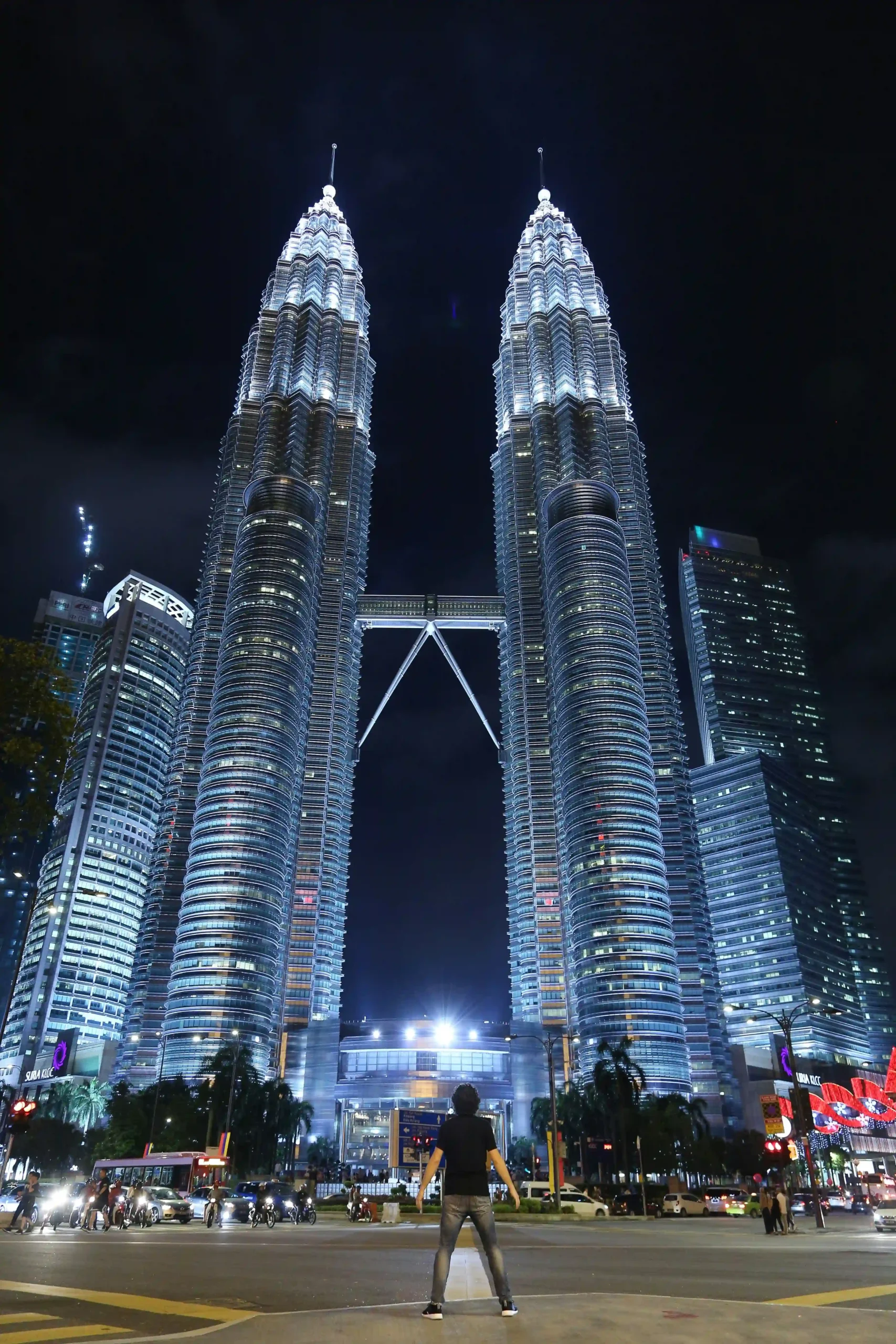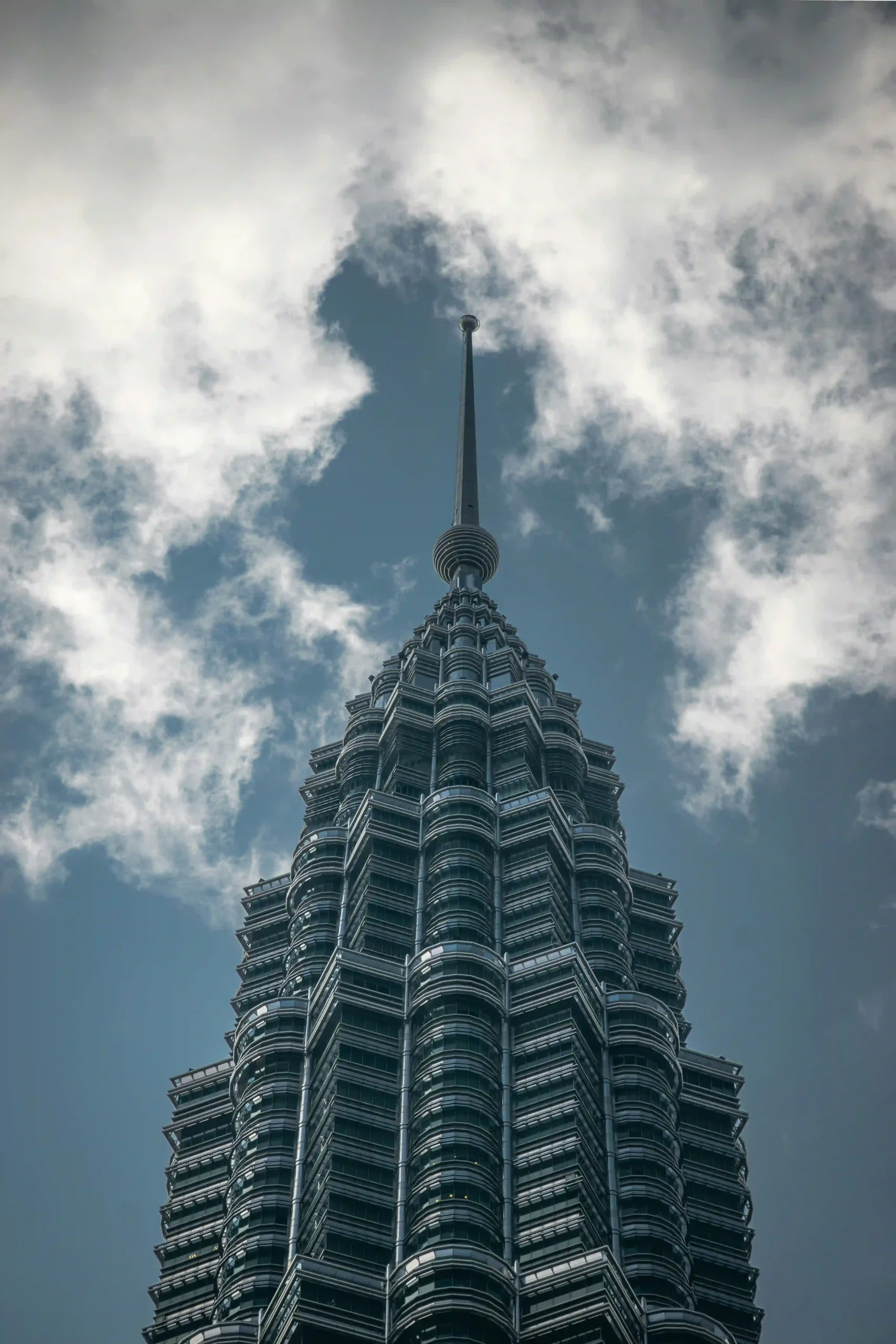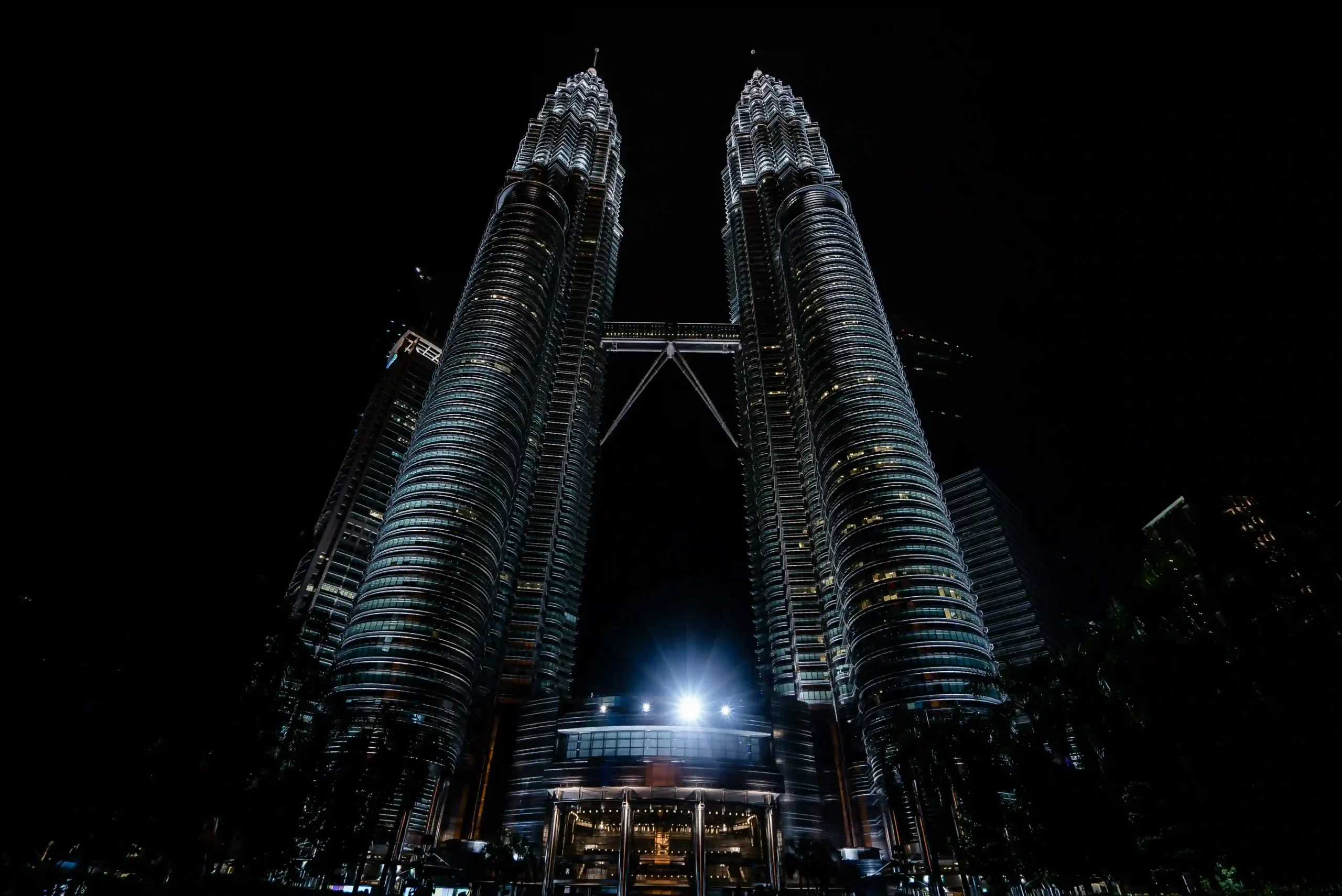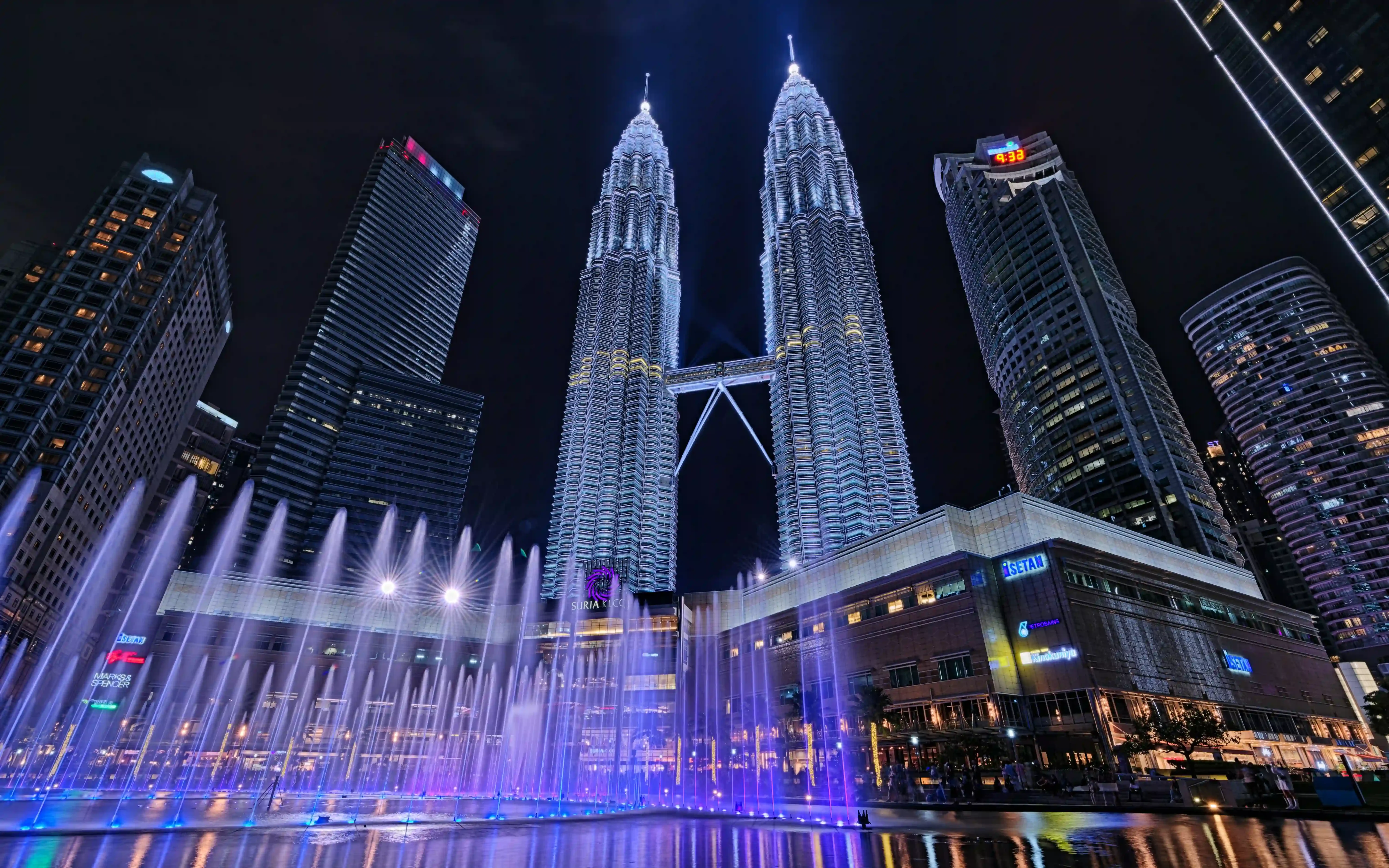The Petronas Towers have defined Kuala Lumpur’s skyline since their completion in 1998. These twin towers symbolize Malaysia’s leap into global modernity and remain a powerful emblem of national pride. Upon completion, they surpassed the height of Chicago’s Willis Tower by a mere 33 feet (~10 meters) to claim the title of the world’s tallest buildings. The record stood for six years until 2004, when the Taipei 101 surpassed them. They continue to hold the record as the tallest twin towers globally.
Designed to blend technological innovation with Islamic heritage, the towers transcend their role as office buildings to stand as cultural landmarks. Their unique eight-pointed star floor plan, reflective stainless steel and glass façade, and the world’s highest skybridge create a striking balance of engineering prowess and aesthetic elegance.
Tower Stats
- Height (to tip): 1,483 ft (452 m)
- Number of towers: 2 (identical height)
- Floors: 88 (plus 5 basement levels per tower)
- Observation deck: 86th floor (Tower 2) + Skybridge (41st & 42nd floors)
- Construction period: 1992–1998
- Construction speed: ~6 years
- Architect: César Pelli
- Design style: Postmodern with Islamic influences
- Cost: $1.6 Billion USD
- Structural material: High-strength reinforced concrete with a stainless steel and glass façade
- Elevators: 29 double-deck elevators per tower (plus service elevators)
- Total floor area: ~4.25 million sq ft (395,000 m²) combined
- Official opening: August 31, 1999
Architecture and Design
Designed by Argentine-American architect César Pelli, the Petronas Towers reflect Malaysia’s cultural identity and futuristic ambitions. The floor plan, inspired by the Rub el Hizb, an Islamic geometric motif, forms an eight-pointed star from two overlapping squares, symbolizing harmony and structural efficiency.
Unlike many skyscrapers that rely on steel frameworks, the towers use high-strength reinforced concrete, chosen for its local availability and superior performance against Malaysia’s wind loads. The exterior’s stainless steel and glass cladding reflects sunlight by day and glows vibrantly at night, enhanced by programmable lighting displays.
Skybridge and Observation Decks
The double-decker skybridge, connecting the towers at the 41st and 42nd floors, is the highest skybridge between any two skyscrapers in the world, suspended 558 ft (170 m) above ground. This iconic feature symbolizes the link between vision and reality. It is not rigidly fixed, allowing it to slide between the buildings to accommodate tower sway under wind or seismic activity—an engineering feat ensuring safety and flexibility. Visitors can access the skybridge and the 86th-floor observation deck in Tower 2 for panoramic views of Kuala Lumpur.


Thank you Photographers! Carles Rabada and Mark Novak on Unsplash
Commercial Tenants and Use
The Petronas Towers are a bustling commercial hub. Tower 1 is fully occupied by Petronas, Malaysia’s national oil and gas company, while Tower 2 hosts multinational corporations such as Microsoft, Bloomberg, IBM, McKinsey & Company, and Al Jazeera. At the towers’ base lies Suria KLCC, a premier shopping mall with luxury retailers, restaurants, an art gallery, and the Petrosains Science Discovery Centre.
Situated within the 100-acre Kuala Lumpur City Centre (KLCC) development, the towers are part of a vibrant urban ecosystem that includes the Kuala Lumpur Convention Centre, the Dewan Filharmonik Petronas concert hall, and a 50-acre park.
Sustainability and Urban Role
While not initially designed as green buildings, the Petronas Towers have embraced sustainability through retrofits. Energy-efficient lighting, water conservation systems, and improved waste management have reduced their environmental footprint. The high-performance glass façade minimizes heat gain while maximizing natural light. The surrounding KLCC Park, with its symphony fountain, jogging track, and children’s playground, enhances urban livability and promotes green space engagement.
Construction Challenges
Building the Petronas Towers was a monumental engineering feat, marked by significant challenges. The site’s soft, limestone-heavy soil required the world’s deepest foundations at the time, with piles driven over 100 meters into the ground to ensure stability. This process demanded precise geotechnical engineering to prevent settling or tilting.
The competitive construction of the towers—Tower 1 by Japan’s Hazama Corporation and Tower 2 by South Korea’s Samsung C&T—added complexity, as each team raced to complete their tower first while maintaining safety and quality. The tropical climate posed further hurdles, with high humidity and frequent rain delaying concrete pours and requiring specialized curing techniques. Approximately 7000 workers, coordinated across multiple contractors, ensured the project met its ambitious six-year timeline.



Thank you, Photographers! Filipe Freitas, Catalin Pop, and Kevin Olson on Unsplash
Global Recognition and Impact
The Petronas Towers have garnered international acclaim for their architectural and cultural significance. In 2004, they received the Aga Khan Award for Architecture, recognizing their innovative integration of Islamic design principles with modern engineering. Their striking silhouette has made them a staple in global media, from Hollywood films like Entrapment (1999) to video games and documentaries, cementing their status as a symbol of modern Asia.
The towers have inspired skyscraper design worldwide, influencing projects that blend cultural motifs with cutting-edge technology. They also boosted Malaysia’s tourism and economic profile, drawing millions of visitors annually and establishing Kuala Lumpur as a global city. Their enduring record as the tallest twin towers underscores their unique place in architectural history.
Fun Facts
- The foundations for the towers, drilled up to 120 m deep, remain the deepest foundations of any building in the world.
- The towers have 32,000 windows across both structures.
- Tower 1 was built by Japan’s Hazama Corporation; Tower 2 by South Korea’s Samsung C&T, sparking a competitive race to completion.
- The towers’ lighting system supports dynamic displays for events and holidays.
- They held the “World’s Tallest Building” title from 1998 to 2004 and remain the tallest twin towers.
Cultural Legacy
The Petronas Towers stand as a striking fusion of engineering prowess and cultural identity, symbolizing Malaysia’s emergence on the global stage. Their twin silhouettes reflect both futuristic ambition and deep-rooted tradition. More than just skyscrapers, they are enduring icons of progress, unity, and national pride.

